Mike is more gregarious than I; he is always eager and
willing to be a part of a group. So when FROG Bob mentioned he would like to do a trip to the Canadian Maritimes, but could not find an opportune time to
schedule it, Mike and our friend Guy volunteered to take on the responsibility
of planning and leading a trip to eastern Canada. Unfortunately, due to health issues, Guy and
Lil were not able to join us on this adventure, but were certainly with us in
spirit.
 |
Peggy's Point Lighthouse at Peggy's Cove, NS
The most photographed lighthouse in Canada |
Mike has the perspective that “everything will be just
fine” whereas, after nearly thirty years of teaching, I fret about the
possibility of what could potentially go wrong and feel responsible for people
in my “care”. Mike assured me these were
responsible adults and seasoned RVers, and, fortunately, he was right. (I can’t believe I just put that in print.) Our fellow travelers were a pleasant group
who meshed well together. From comments that we received both during and after the trip, I think I can
speak for the group when I say that we did, indeed, have Great Times in the Maritimes.
 |
"What could go wrong?" Well, you could be attacked by a giant
lobster. Yvonne in front of The Gables restaurant, where we enjoyed
a delicious dinner, on both this trip and our trip two years ago |
 |
| Kiwanis Oceanfront Camping, St. Andrews, NB as seen from the deck of the Jolly Breeze |
FROGs (Forest River Owners' Group members) from fifteen U.S. states and one Canadian province rendezvoused in New Brunswick, in the lovely town of St.
Andrews by the Sea. It is easy to see
why this picturesque spot was a favorite of the wealthy in the late nineteenth
and early twentieth centuries. Our
first three days together were spent at Kiwanis Oceanfront Campground. As the name implies, this delightful campground is literally right across the street from the ocean, or more
precisely, Passamaquoddy Bay, an inlet off of the Bay of Fundy. Close by are the grand historic Algonquin
hotel and the multi-award winning twenty-seven acre horticultural masterpiece,
Kingsbrae Garden.
At each of our six stops, Mike had planned some type of
group activity and, in some cases, a meal, as well. Our adventure for this stop was a whale-watching
tour aboard the tall ship Jolly Breeze. Because of the size of our group, half were
booked on the morning cruise and the other half on the afternoon voyage. We had decided that Mike would accompany one
of the tours and I would accompany the other.
My assignment was the morning cruise, and we left the wharf in a jovial
mood. Breakfast was served on board,
and about half-way to the area where there were reports of whale sightings, the
engine – a new diesel that had been installed only two years earlier –
quit. All attempts to restart it were
unsuccessful, and the owner came out in a small boat to change the “motherboard”
in the computer that controlled the engine’s electronics. Still nothing. The naturalist on board was doing her best to
keep the passengers entertained with viewings of the various sea creatures
carried in a salt-water tank on the ship.
The company then dispatched a Zodiac to tow the Jolly Breeze back to
port. As we neared the wharf, it was
finally determined that a blown 37-cent fuse was the culprit. The tour company’s owners could not have been
nicer. They offered three options: Re-book those who wanted to go out on the
tall ship for the following morning, book anyone who wanted to go on their
Zodiac tour that afternoon (the Zodiac trip is actually $25.00 per person
higher, but they offered it at the same price) or refund the cost of the
tickets. Mike’s group sailed aboard the Jolly
Breeze that afternoon. They
encountered no mechanical problems, and sighted and followed two humpback
whales.
 |
| Our whale-watching cruise was aboard the tall ship Jolly Breeze |
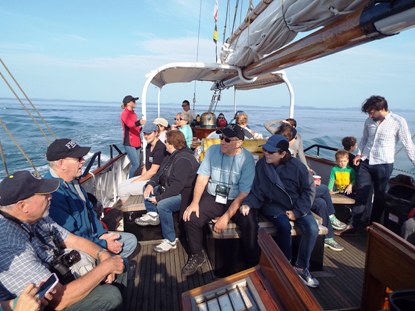 |
| FROGs on deck |
 |
| More FROGs on deck |
 |
And still more FROGs on deck
(this photo courtesy of Georgette B.) |
 |
When the vessel broke down, the on-board naturalist kept the passengers
occupied with a "show-and-tell" of some of the marine creatures carried on board |
 |
And finally, on the afternoon cruise, "there she blows"
(this photo courtesy of Georgette B.) |
 |
Two Humpback whales spent about 20 minutes swimming near the ship.
It was a thrilling sight. (this photo courtesy of Georgette B.) |
 |
We stopped to watch the seals on this rock island. At low tide, the top of
the rock is exposed, and the seals sun themselves. At high tide, the rock
is completely submerged and the seals swim around until the next low
tide, but no natural predators can get to them here. |
 |
You can't be a pirate on the Jolly Breeze without
a tattoo. Many of the FROGs sported face paint,
courtesy of one of the ship's crew |
On several evenings – two in St. Andrews - we gathered
around a campfire. An added bonus was that
one of our travelers had brought along a high-powered telescope. We had the opportunity to see craters on the
moon, the moons of Jupiter and the rings around Saturn. Fascinating!
Thank you, Dan.
 |
| Gathered around the fire on our last night in St. Andrews. |
Prince Edward Island was our next destination. We crossed the Confederation Bridge and made
our way to the Cavendish area, the setting for Anne of Green Gables, made
famous by author Lucy Maude Montgomery and her red-haired pigtailed heroine,
Anne Shirley.
 |
Construction of the bridge began in October 1993 and was completed in May 1997,
at a cost of $1.3 billion Canadian. The bridge is 8 miles (12.9 km) in length. Before
its official naming, Prince Edward Islanders referred to the bridge as the "Fixed Link" |
On a beautiful Saturday evening, the group met at the
Confederation Center in Charlottetown for a production of “Anne of Green
Gables”, the longest-running musical in history.
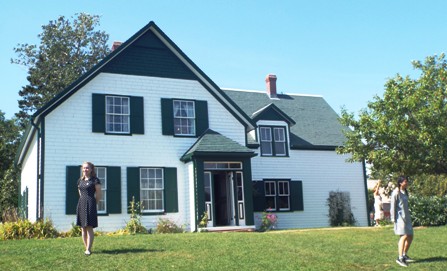 |
The original "Green Gables" house in which Lucy Maud Montgomery lived has been
torn down. This replica is period-authentic, down to the furnishings and some of the
pieces of jewelry that Montgomery mentioned in her book, Anne of Green Gables |
 |
| Beautiful flowers bloom all over the island |
 |
| FROGs visit around a picnic table at Sunset Campground on PEI |
Sunset Campground, our base on PEI, is only about two
miles from Prince Edward National Park. People
had the opportunity to drive through the park to view the dramatic red cliffs
or walk along long stretches of sandy beaches. On Sunday afternoon Mike and I wandered into
the small town of North Rustico and came across a flea market, which added to
the “local” feel. One structure in that
tiny town is the Doucet House. Built in
1772, it may be the oldest Acadian dwelling in the province.
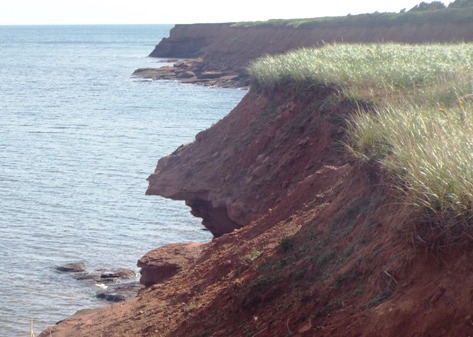 |
The red color of the soil on Prince Edward Island
is due to the high iron-oxide content |
 |
Prince Edward Island is located in the Gulf of St. Lawrence,
and is sometimes referred to as the "Garden of the Gulf" |
 |
The island is known for its red sand beaches, and is renowned for great seafood, like
lobster and mussels. We spotted Jim & Sue and Dan & Leslie walking along the beach. |
 |
The island was discovered by Jacques Cartier in 1534, but was not settled permanently
until the 1700's. The first settlements were around the harbor at what is now Charlottetown. |
 |
| Fishing boats in the harbor at North Rustico |
 |
Stacks of lobster traps. The lobster trap was invented in 1808
by Ebenezer Thorndike of Swampscott, Massachusetts |
 |
Fertile farmland abounds on Prince Edward Island. The island produces
approximately 25% of the potato crop grown annually in all of Canada. |
A group dinner at
the restaurant Chez Yvonne featured simple,
hearty entrées including fish and chips, seafood chowder and salad, or
pan-fried haddock. We had eaten here on
our previous trip to PEI, and just like the first time, the restaurant did not
disappoint.
 |
| Sunday evening dinner at Chez Yvonne, Sept. 2, 2018 |
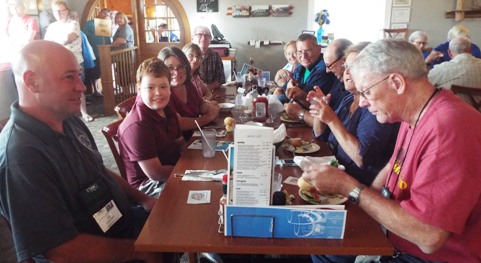 |
| Sunday evening dinner at Chez Yvonne, Sept. 2, 2018 |
 |
| Sunday evening dinner at Chez Yvonne, Sept. 2, 2018 |
Crossing the Confederation Bridge again, we headed toward
our third Canadian province, Nova Scotia, and its capital, Halifax. A bus tour of Halifax, complete with a tour
guide in full Scottish regalia, included a walk through the city’s Public
Garden, a visit to the Citadel, and a very interesting stop with a walking tour
through Fairview Lawn Cemetery, where 121 of the victims of the RMS
Titanic
disaster are buried. (Twenty-nine
others are buried in Halifax: nineteen
in Mount Olivet Catholic Cemetery and ten in Baron de Hirsch Jewish
Cemetery.) Our tour guide, John James,
provided details about, and in some cases, pictures of, the men, women and, in
a few cases, children buried in Fairlawn.
Forty-two of the graves in Fairlawn contain the bodies of unidentified
victims; the gravestones simply are numbered with a number that was assigned
consecutively as the bodies were recovered.
In the days after Titanic sank, searchers recovered the
bodies of 337 of the 1,514 people who were lost that night. 119 were subsequently re-buried at sea. 209 bodies were returned to Halifax. 59 of those were claimed by relatives and
taken to be buried elsewhere, and 150 bodies were buried in Halifax.
 |
| Waiting for the bus to begin our tour of Halifax |
 |
John James, out tour guide, in his kilt, talks to the group at the entrance to Fair-
view Lawn Cemetery. He now wears a FROG pin on his kilt, courtesy of Mary F. |
 |
While many of the headstones are rather simple markers installed in 1912,
some families paid for and placed individual, personalized stones. Everett
Elliott, a member of the crew, stayed at his post and was lost with the ship
and "...showed once more to all the world how Englishmen should die." |
 |
A floral display in the Public Garden commemorating the 200th anniversary
of Dalhousie University, one of the oldest universities in Canada. |
 |
A replica of the Titanic, floating in one of the lakes in the
Public Gardens, makes a great perch for this Blue Heron |
 |
The bandstand was built in 1867, designed by Halifax architect Henry Busch.
It is used for free concerts on Sunday afternoons during the summer |
 |
The Halifax Public Gardens are Victorian-era gardens formally
established in 1867, the year of Canadian Confederation |
 |
The 78th Highlanders, a ceremonial re-enactment
unit, stands guard at the Citadel in Halifax |
 |
FROGs outside the entrance to the Citadel, overlooking Halifax harbor. The Citidel
has never been under siege, and this group surely isn't going to be the first to attempt it. |
Over the following couple of days, our travelers had time
to visit places of interest to them. A
number of us chose to visit Peggy’s Cove and take snapshots of the most
photographed lighthouse in Canada. Nearby was the Swissair Memorial, a monument
honoring the victims lost in the crash of Swissair flight 111 off the coast of
Nova Scotia on September 2, 1998. A bit
further from Halifax, the city of Lunenburg, a UNESCO site, offered a variety
of shops and restaurants situated on a pretty harbor.
 |
| Near Peggy's Cove, Nova Scotia |
 |
| Along the coast of Nova Scotia, between Peggy's Cove and Lunenburg |
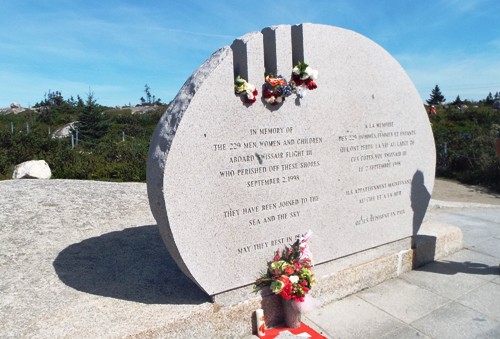 |
Monument honoring the 229 lives lost on September 2, 1998, when Swissair
flight 111 crashed en route from JFK in New York to Geneva, Switzerland |
Leaving Halifax, we headed east to Cape Breton Island and
the “must see” Cabot Trail. We used Bras
d’Or Lakes Campground near the town of Baddeck as our base. The Cabot Trail offers some of the most
dramatic views in the Maritimes along the 180 mile circular drive. In Baddeck, the Thomas Edison Museum showcased
the highly diverse interests of this brilliant man. Attending a ceilidh – a “gathering” or what is
sometimes referred to as a kitchen party, allowed our group to enjoy some very
talented musicians and experience some regional culture. Day trips offered opportunities to visit Sidney
to see the world’s largest fiddle, or to explore the largest reconstructed
fortress in Canada, the fortress at Loiusburg.
Our favorite venue, about an hour from Baddeck, is the Scottish Highland
Village Open-air Museum where costumed re-enactors immerse you in the immigrant
experience from 1740 to the 1950s. Of
course, one cannot leave the east coast without experiencing a famous “lobster
supper,” and our FROGs did just that.
 |
This is not a painting, but a hooked rug depicting the Crucifixion of Christ. It is on display
at the Museum of Hooked Rugs and Home Life in Les Trois Pignons in Cheticamp. |
 |
With a very short window to complete roadwork, repairs are
constantly being done on the Cabot Trail. |
 |
The lighthouse at Neils Harbour on the Cabot Trail. (There is also
a pretty good fish restaurant here called the Chowder House.) |
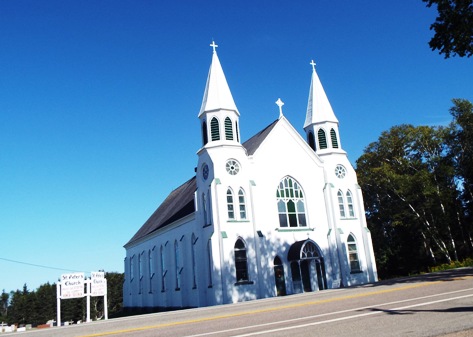 |
St. Peter's Roman Catholic Church, in Ingonish Beach, Cape Breton.
Built in 1913, this church is now 105 years old. |
 |
| Bras d'Or Lake, taken from the Highland Village Museum at Iona, Cape Breton |
 |
Eleven historic structures depict the lives of the Gaelic people from their
origins in Scotland (in this 1740's stone and sod home pictured above)
to their arrival in the new world, and up through the early 20th century |
 |
The barn, originally built near Iona in the mid-nineteenth century, was disassembled
by hand, moved here, and re-assembled. It is built with hand-hewn beams |
 |
The most modern home in the village is the beige one, facing us. It would
date to about 1900 The two buildings to the right of the house are the white
schoolhouse (circa 1917) and the gray store (circa 1920) |
 |
Costumed re-enactors in each building tell stories and give you a picture
of what life might be like during the time period depicted by that building |
 |
The working blacksmith shop still uses the same tools and techniques that
would have been used in blacksmith shops from the late 1800's to the mid-1900's |
 |
| The star of the show at our "down East lobster supper" |
 |
| Lobster, seafood chowder, and buckets of mussels |
A brief stop in the small town of Pictou, Nova Scotia gave our
group the opportunity to tour a replica of the ship Hector which brought the
first settlers from Scotland to the shores of mainland Canada in September of
1773.
 |
FROGs gathered in the lobby of the Hector Heritage Museum,
awaiting our tour.on a chilly morning. |
 |
| Replica of the ship Hector that brought 189 Scottish Highlanders to Pictou in 1773 |
 |
Hector was an old ship, and in poor condition when she made the 1773 crossing, which
took 11 weeks, including a 2 week delay when she ran into a gale off of Newfoundland |
 |
The Museum of Industry in Pictou County houses the
oldest working steam locomotive in Canada |
 |
| An exhibit of quilting in Nova Scotia |
 |
| Mobile Industrial Arts Classroom from the early 1950's |
We had been very fortunate to have had warm, dry days, with
only a few overnight showers during most of our trip, and so it was not
terribly disappointing – nor surprising – that we left Pictou, heading to our
final destination, in a light, misty drizzle.
Saint John, New Brunswick, was the last stop on our journey. The group activity here was a bus tour of
the city, with a stop at the old City Market; a photo stop on a peak
overlooking the harbor; driving tour through downtown, several residential
neighborhoods, and the City Park; and a stop at the Reversing Rapids. At low tide, the St. John River empties into
the Bay of Fundy, causing a series of rapids and whirlpools. At high tide, the water rushing out of the
bay into the river actually causes the river to flow backwards (upstream) for a
distance of more than 80 miles.
 |
| Interior of the City Market, St. John, New Brunswick |
 |
| FROGs pose for a group picture on a hilltop overlooking the harbor in St. John, NB |
 |
| Mike and Yvonne in front of the Reversing Rapids, St. John, NB |
Our group gathered for a farewell dinner on our last
evening to share stories and discuss future adventures. The next morning, following a continental
breakfast, the FROGs went their separate ways.
 |
| Farewell Dinner at Lily's Lakeside Dining in St. John, NB, Sept. 13, 2018 |
 |
| Farewell Dinner at Lily's Lakeside Dining in St. John, NB, Sept. 13, 2018 |
 |
| Farewell Dinner at Lily's Lakeside Dining in St. John, NB, Sept. 13, 2018 |
 |
| Farewell Dinner at Lily's Lakeside Dining in St. John, NB, Sept. 13, 2018 |
 |
| Farewell Dinner at Lily's Lakeside Dining in St. John, NB, Sept. 13, 2018 |
 |
| Farewell Dinner at Lily's Lakeside Dining in St. John, NB, Sept. 13, 2018 |
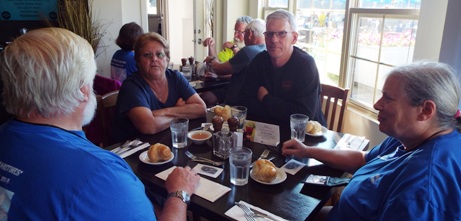 |
| Farewell Dinner at Lily's Lakeside Dining in St. John, NB, Sept. 13, 2018 |
 |
| FROGs gather to say farewell on a bright, sunny morning in St. John, NB |
We always enjoy new adventures and we hope that this
first-ever FROG Great Times in the
Maritimes caravan gave our travelers the opportunity to go home with fond
memories and a few of their own new Road Stories.
If you would like to see more pictures of the Canadian Maritimes, below are
links to three blogs that we wrote following our initial trip there in June, 2016







